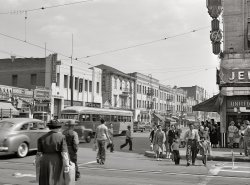
MAY CONTAIN NUTS

Search Shorpy
SHORPY ART

Framed or unframed, desk size to sofa size, printed by us in Arizona and Alabama since 2007. Explore now.
Join and Share
Ad-Free Shorpy
Shorpy is funded by you. Patreon contributors get an ad-free experience.
Learn more.

Recent comments
- Indiana Harbor Belt abides
- Freezing haze
- Corrections (for those who care)
- C&NW at Nelson
- Fallen Flags
- A dangerous job made worse
- Water Stop
- Passenger trains have right of way over freights?
- Coal
- Never ceases to amaze me.
- Still chuggin' (in model form)
- Great shot
- Westerly Breeze
- For the men, a trapeze
- Tickled
- Sense of loneliness ...
- 2 cents
- Charm City
- What an Outrage
- Brighton Park
- Catenary Supports
- Just a Little Before I was Born
- Afternoon normal
- The Flat Iron Cafe survives
- Aging in Place
- Raise your hand
- Good and Bad
- Oh, the 70's
- Nooooooi
- The aluminum tubing
Member Photos
The Shorpy
Print Emporium
Print Emporium
Search Shorpy
Search results -- 30 results per page
- Cajun Spice Girls: 1938
- ... Festival in Crowley, Louisiana." 35mm nitrate negative by Russell Lee for the Farm Security Administration. View full size.
Trend setters ... Posted by Dave - 03/22/2012 - 12:32am -
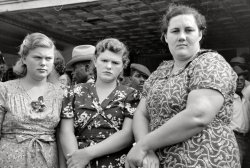
- Dumped: 1942
- ... in the construction of Shasta Dam." Acetate negative by Russell Lee for the Office of War Information. View full size.
Butane -- ... Posted by Dave - 06/25/2022 - 12:53pm -
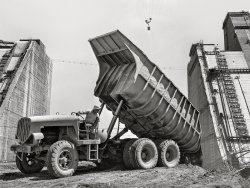
- Mom and Pop: 1937
- ... near Winton, Minnesota." Medium format nitrate negative by Russell Lee for the Resettlement Administration. View full size.
They are quite ... Posted by Dave - 03/04/2010 - 12:53am -
![Mom and Pop: 1937 August 1937. "Storekeeper and wife in front of their store at Section 30. 'Bust' iron mining town near Winton, Minnesota." Medium format nitrate negative by Russell Lee for the Resettlement Administration. View full size.
They are quite endearingWould this have been what the song "Sixteen Tons" called a "company store"?
How many souls are on its books?
A sweet looking coupleNot sure if they are husband and wife, brother and sister or just good friends, but they look like they've been together for years, have seen a lot together and still enjoy each other's company. A great natural pose!
[The mystery of their relatedness can be solved by, quel surprise, reading the caption. - Dave]
Thanks Again, Shorpy!You did it again: another photo that brought a smile to my face. What a happy and sweet looking couple.
Whatza whizitReally neat old Lee denim sign in the upper left. Has their early "house" or triangle logo and "slanted e" logo. Whizits were Lee jeans and overalls with zippers. The first jeans maker to use 'em. Less draft and no puckers -- smoother lines. When Levi's finally began offering 501ZXX jean with a zipper, one irate cowboy who had been sent a pair with his order as a promotion of the new product sent them back -- "It's like peeing through the jaws of an alligator!"
Pipe SmokingDang... I miss my pipe. I finally get old enough to not look odd smoking a pipe, and I have to go and get all health conscious.
Fleischmann's YeastAh yes, Fleischmann's Yeast. At one time, they operated a large factory in Peekskill, NY and when it was up and producing, a karge part of the Mid-Hudson Valley could inhale its scent.
Worth a thousand words...Much as I love those photos, a moment frozen in time does not need bustling streets and signs galore to say as much a this one does. Really a wonderful backward glance—thanks, Steve.
Whizits AKA zippers"Railroad men tell us we must have made Lee Whizit Union-Alls and Overalls for them. We did- and we made
them so handy, roomy, keen looking and comfortable that you find men on famous trains of every system wearing Lee Whizits.
Railroad men with pride in their jobs-men who have service records in the cabs of famous trains-say, "We feel dressed up in Whizits."
The Whizit fastener, exclusively Lee, means no buttons to bother - to come off - to sew on. Then too, Lee fabrics with their distinctly different weaves are
stronger, wash more easily and cleaner, keeping color, shape and clean-cut appearance through months of hard service. The Whizit is a real man's work garment. More Lee garments are worn than any other make."
http://thelibrary.springfield.missouri.org/lochist/frisco/magazines/fem_...
Sans PitchforkAmerican Gothic without the pitchfork, frowns and barn.
Denver SandwichHits the spot everytime.
Wonder what the apron says?I love this photo. I grew up in North Carolina and I remember store keepers that looked much like this couple. I like the looks of his hands, they look like he has done some good honest work with them. Great picture.
OutstandingDave, you've made my day! One of the best pictures yet on Shorpy! A perfect pair.
Denver Sandwich CandyI had never heard of such a thing! The only photo I could.
TV Mystery SolvedSo this is where Sam Drucker got his start!
They must be....in love. I am always impressed when I see a couple that look as comfortable around each other as these two do. I only wish my marriage had been so successful.
Who has the keys to the Delorean?There's something I love about this couple. They look like people you could meet today, or during any time period really. Great picture!
Denver Sandwich Candy"Crispy wafers surrounded by creamy caramel and nuts coated with plenty of milk chocolate." What's not to like? Made by the Sperry Co. in Milwaukee.
"Take your brother with youWhen you go to the store, pick up our meat order and Mr. Burge will have a surprise for you." Usually it was a dime credit for coke or candy for us. Our grocer was a butcher, baker, produce manager, and stock clerk. He did it all with help from his wife, probably just like the folks in the picture. He also knew every customer's name including their kids.
She looks like my grandmaShe wore a tidy little hairnet too.
Great photo!Reminds me of all the mom and pop stores of days gone by. And they're actually smiling for a change.
Empress"We Feature Empress Coffee" -- that's what the apron says.
Laugh lines don't lieBoth of them have plenty of laugh lines around their eyes, indicating a lot of fun in their lives.
I bet they were a hoot and a half to hang with.
7 Layer cakeThe Denver Sandwich reminds me of what we New Yorkers called Seven Layer Cake. Alternate layers of vanilla and chocolate butter cream. My God, how I wish I could walk into one of those Bronx bakeries and buy a slab of that. Imitations are available everywhere including Palm Desert, California, where I am spending the winter.
Dr. GrabowThey're in love, seems to me. Radiates from them like sunshine. I especially like the pipe; it looks like one of my Dad's Dr. Grabows. He's unconsciously tamping it with his finger, as my dad used to do, and as I do now,on the rare occasions that I smoke.
Denver sandwichStrange, here in Canada we refer to a "western sandwich" as a "Denver Sandwich" and usually it's an "Open faced Denver" that is the preferred.
Mom and Pop storekeepers identified!"Oppel’s Store, fore-runner of modern shopping centers, was famous throughout the area and did so well that eight clerks, a bookkeeper and two butchers were kept full time." -Minnesota Humanities Center
This is Joe Manning. I managed to identify this couple by contacting the local newspaper, the Ely Echo, which ran a short article with the picture. They were William and Nellie Oppel, who ran Oppel's store, near the iron ore mine. William died at the age of 72, about two years after this photo was taken. You can see more information, and more photos of the store, on my website.
http://morningsonmaplestreet.com/2015/01/05/3564/
(The Gallery, Russell Lee, Stores & Markets)](https://www.shorpy.com/files/images/8b36767u.thumbnail.jpg)
- Dam Dump: 1942
- ... shovel dumps dirt into dump truck." Acetate negative by Russell Lee for the Office of War Information. View full size.
Dust Off That ... Posted by Dave - 07/14/2022 - 1:43pm -
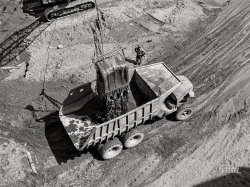
- California Here We Come: 1939
- ... Elmer Thomas at the wheel. 35mm nitrate negative by Russell Lee for the Farm Security Administration. View full size.
The Dog ... Posted by Dave - 10/22/2018 - 1:11pm -
![California Here We Come: 1939 July 1939 near Muskogee, Oklahoma. "Migrant family ready to depart for the journey to California." Elmer Thomas at the wheel. 35mm nitrate negative by Russell Lee for the Farm Security Administration. View full size.
The DogTying off Scout, or Butch, or whatever his name was by the neck might not have been the smartest thing, but Brother's holding on, and at least they didn't leave him behind. And, the journey didn't involve screaming down the interstate at 75 mph. I bet he survived the trip, as did the ladies riding topside. I hope California was good to them all.
WoofWhere else was the dog suppose to ride? I agree, at least they didn't leave him behind.
Is the car a Rolls-Royce?!Is the car a Rolls-Royce?! Or is there another maker with the flying lady?
[It's a circa 1929 Ford Model A pickup truck. - Dave]
Spirit of ExtasyThe radiator ornament is somewhat reminiscent of the "Spirit of Extasy" designed by Ch. Sykes for Rolls-Royce in 1911, but it is not the same. Personalizing your car with a custom radiator ornament was very popular in the thirties and there were hundreds to choose from. If you happen to have a frosted glass ornament by the French designer Lalique, left over from your grandfather's phaeton, you are sitting on an item that could fetch a multiple of $10,000 at auction if in mint condition. I wondered too about the fancy figure on this otherwise clapped-out Ford A, but I guess it was on the car when these people bought it.
[Ahem. Ecstasy, not "extasy." - Dave]
Pity the dogPlease tell me the poor mutt didn't ride that running board across three states.
Pity the dog?!?!What about the people living through the Dust Bowl trying to survive and being uprooted from their home. I'd say the dog's damn lucky he didn't get left behind so they could save a couple pennies a week on food.
Good grief! More compassion for a dog than people...talk about messed up priorities.
Lucky dog on running board I agree. At least the dog got to go with the family. Speeds were likely 20-30 mph if they were lucky enough to be on a good road. Chances are that the dog survived just fine.
The Thomas FamilyThe whole family ended up in Bakersfield, California, dog and all. Elmer was my great-grandfather. Others in the truck are Edna his wife, Tommy, Frank, Viola and Ruby.
The Thomas FamilyVery interesting to me that I found this on the net. Since Tommy is my grandfather. It's amazing what you can find once you start doing some research.
Check the Oil (Can)Looks like they made sure to change or add a can of Esso oil before the trip westward.
Things are not quite as they seemReading the comments, the first thought to come to mind is "don't knock it if you haven't done it." Most of the women in this ex-Okies family would have taken the 10 gauge to any man they though "wasn't doing them fair" and I am sure the ladies here would have done no less.
But the ventilation in the old Ford at the typical road speed of thirty MPH or so was notable for blowing a gale in the occupants faces, while leaving the rest of them in a dead calm. And in leaving the occupants sitting in a puddle of sweat sometime around mid morning.
Three men on a warm day usually got pretty ripe in a hurry. Given the choice most male non-drivers preferred to ride on the running board from the first of May until first frost. Most of the ladies preferred the relative comfort of the rear, where there was more freedom to move about, and always a fair breeze with little chance of accidental overexposure.
On the other hand, the dog had probably ridden everything in sight, and the running board was not an uncomfortable station. Fido would soon lie down with his head comfortably on the front fender, raising his head as an interesting scent wafted down the wind.
Ahhh, those were the days!
Old Radio Man
Dust Bowl HumorSome years back PBS ran a wonderful documentary on the migration from the Dust Bowl to California. Many of the migrants survived and prospered again as farmers in the Great Central Valley. One of them recalled a joke his dad told as they were leaving Oklahoma: "How do you tell a rich Okie from a regular Okie? - Your rich Okie has two mattresses strapped to the roof of his car!"
Elmer and Edna Thomas Family 1939I have copies of the photos that Russell Lee took of the Thomas Family on their journey to California from Oklahoma during the Dust Bowl Days. He followed them throughout their entire trip. What great memories. I am their granddaughter. My mother "Ruby," age 13, is the little girl in the back of the truck with her Aunt Viola. For all that wondered, the dog actually rode in the back with my mom
(The Gallery, Cars, Trucks, Buses, Dogs, Great Depression, Russell Lee)](https://www.shorpy.com/files/images/SHORPY-8a26684a.thumbnail.jpg)
- The Crab Shack: 1941
- ... Oregon, a fishing town." Medium format acetate negative by Russell Lee for the Farm Security Administration. View full size.
Oregon Coast ... Posted by Dave - 03/21/2022 - 11:23am -
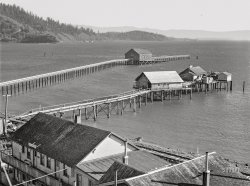
- Taps: 1942
- ... bowls used by the Japanese-Americans." Acetate negative by Russell Lee for the Farm Security Administration/Office of War Information. View full ... Posted by Dave - 08/23/2022 - 12:34pm -
![Taps: 1942 July 1942. Rupert, Idaho. "Minidoka War Relocation Center -- former CCC camp now under FSA management. Wash bowls used by the Japanese-Americans." Acetate negative by Russell Lee for the Farm Security Administration/Office of War Information. View full size.
Wash bowlsI think I understand the reason for the different levels of the hot and cold taps: to accommodate the two different pipe feeds behind the backsplash. But why no P-trap on the drains?
This is the ladies' washroomAccording to Densho Encyclopedia, the ladies were allotted 14 wash basins to the men's 12, as follows:
[There are 15 basins in this photo. - Dave]
I also counted 15. I concluded the description is from memory and off by one, or maybe one wasn't usable. Didn't know what else to do because I think both sources are credible. Since 15 is closer to 14 than it is to 12, I decided this must be the ladies' side.
Latrines:
The laundry and bathroom buildings housed the laundry on one side of the "H" and the bathrooms and showers on the other, with a 1,350 gallon coal heated water heater in the middle. The bathroom side was divided into men's and women's sections. The men's had ten "toilet stools," along with four urinals, twelve shower heads, and twelve wash basins; the women's had fourteen "toilet stools," along with eight shower heads, four bath tubs, and fourteen wash basins. There were initially no partitions between either the toilets or showers; they were later added to the women's facilities, but never to the men's. The laundry section included eighteen "double laundry trays." As noted above, the flush toilets were not operational for the first several months due to delays in completing the sewer system.
P-TrapsWhy no traps on each washbowl? I can think of two explanations.
1) Who cares if these folks get a little whiff of sewer? (sad, but possible)
2) Simplicity: Since this is at worst gray water, there will be little but soapy water flowing. One common p-trap at the far end will suffice.
[It would be (already is?) in the middle, not the end. - Dave]
(The Gallery, Relocation Camps, Russell Lee, WW2)](https://www.shorpy.com/files/images/SHORPY-8c25436a.thumbnail.jpg)
- Movie Night: 1942
- ... here, and three birds! Medium format acetate negative by Russell Lee for the Farm Security Administration. View full size.
Re: Third ... Posted by Dave - 04/22/2022 - 8:27am -
![Movie Night: 1942 February 1942. "Tulare County, California. FSA farm workers' camp. At the movies." Not to be outdone by our previous FSA photo, we have two birders here, and three birds! Medium format acetate negative by Russell Lee for the Farm Security Administration. View full size.
Re: Third BirdI see a third, about 7 rows from the front, near the left side. And that plaid shirt (behind Double Flipper) has seen better days, for sure!
I ain't touchin' that!Judging by the looks on some of their faces, the film must be the one about STD's.
Two birds, four eyesI see (at least) two people with strabismus in the crowd.
Two "Thumbs" Up!Apparently the young man inn the foreground is doubly displeased with what he's seeing on the big screen.
Long-lived 16mmThat looks very much like the 16mm projector that I used to show movies for my Army company in 1970. (It was a way to avoid guard duty.) They were regular Hollywood films in the 16mm format. This FSA crowd is probably watching something similar.
Portable 16mm sound projectors were popular from the 1930s to the advent of video cassette players. Beyond that, 16mm film was used for the early seasons of 'Sex and the City' and 'Buffy the Vampire Slayer' and for parts of the films 'The Hurt Locker' and Spike Lee's 'Da 5 Bloods' in 2020.
Multiple Avian DisplayThe double bird and the double dog dare were kept in a boy's arsenal only to be deployed when the situation warranted an extreme measure.
GesturesAs a youngster in the 1950s when living overseas, I learned birding the way Flipper and Two-Birds are doing it. When I first got to the States in the very early 1960s is when I learned that American teenagers did it differently. They folded the fingers into the palm of the hand instead of squashing them straight down. Haven't a clue how adults did it since we never associated with them!
Taking a random sample of folks of various ages from teenage to 70+, all seem to have learned and use the folded fingers versus squashed fingers gesture. Wonder when Americans changed from what is shown in the 1940s to what I learned in the early 1960s.
Movin' on up... the Valley: A double-bird ?? Lord, that boy is Folsom Prison bound !!
Kid near the foreground, left of centerEverybody calls him "Red".
Maybe it was a newsreel… and the kid up front is just expressing his opinion of der Fuhrer.
The Third BirdHas no one spotted it?
I think I see the thirdAnd by a girl! She's on the left-center of the photo, with a kind of crazy look in her eyes.
Birds asideWhy are the three kids in the foreground looking at something to our left while all the people behind them are looking off to our right? And why is the kid front and center in the ratty sweater wearing a white glove on one of his hands cupped over his mouth?
[We'll never know! - Dave]
(The Gallery, Agriculture, Kids, Movies, Russell Lee)](https://www.shorpy.com/files/images/SHORPY-8c23889a1.thumbnail.jpg)
- Speed Demon: 1938
- ... Mississippi." View full size. 35mm nitrate negative by Russell Lee for the Farm Security Administration.
Beelzebubmobile Mississippi's ... Posted by Dave - 03/28/2008 - 1:08pm -
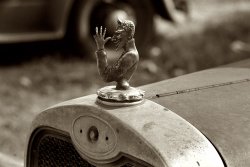
- A Tehama Home Companion: 1940
- ... home. View full size. Medium format safety negative by Russell Lee for the Farm Security Administration.
Cost I wonder how much this ... Posted by Dave - 01/22/2008 - 2:00pm -
![A Tehama Home Companion: 1940 November 1940. Tehama County, California. John Frost and his daughter listening to the radio in their home. View full size. Medium format safety negative by Russell Lee for the Farm Security Administration.
CostI wonder how much this radio cost? It looks like a pretty high end piece of equipment for someone who quite frankly doesn't look like he can really afford it. The again I sometimes wonder how a lot of people who are buying HDTVs can afford it.
tuning dialInteresting to see that the medium-wave am-broadcast band
is "split" (550 kHz-1300 kHz and 1400 kHz- well up to what
back then were common police dispatch/car frequencies).
The top segment may be short-wave (c. 7-MHz to ?) with the
cities/countries listed on it. Of course kHz=kc/s and
MHz=Mc/s in that era as well.
Wedding present or bought on installment by a news junkiePerhaps it was a wedding gift, or it was bought on installment, no credit in those days. It's possible the hubby was a news junkie; remember the year, and the war clouds gathering--shortwave radio would be like the CNN of the 40's. It'd be expensive, but as a commenter said about HDTV it would be the thing to get. Note also the big bound books in the background: dictionaries or encyclopedia volumes?
RadioMy grandparents had one like this, maybe even bigger. I didn't understand all the applications but there was an image of the world and a switch that let you light up different parts of the globe--maybe short wave?
Maybehe wanted a greeeat big set so he could hear it out in the yard.
Radio It might be that the radio and the books are all he has left from better times. I am glad to see that he was getting his child involved in the world. So sad that some respondents try to compare it to today's world and are ready to criticize on such meager information.
Fred AllenI'm reminded of what Fred Allen said: ''I don't hold with furniture that talks.''
Denny Gill
Chugiak, Alaska
RadioMy radio buddy says its an RCA 19K. So yeah, a big console by a name brand. They must have made sacrifices to get that one. I hope they enjoyed it!
The RadioI stand corrected. Thank you, Dave.
Radio techie detailsNow that the unit has been identified, here are some more techie details about it for those interested in such.
http://oldtech.net/RCA/19K-sch.gif
http://oldtech.net/RCA/19K-p1.gif
http://oldtech.net/RCA/19K-p2.gif
http://oldtech.net/RCA/19K-p4.gif
The pushbutton preset tuning is explained. The tuning dial shows that it did cover a goodly chunk of the shortwave bands (1.4-4 and 6-18 MHz). The same tube types were being used in some equipment still produced into the early 1960's.
Re: RadioIn Dave's close-up detail of the dial bezel, the brand name looks like Zenith to me, not RCA.
[It says RCA Victor. - Dave]
John FrostRe Brent's comment, you can read a lot into a photo that may or may not be there. In the 1940's my college educated, former Naval officer grandfather bought a run down farm with no indoor plumbing. In fact, they didn't have indoor plumbing until the 50's. He had some money and more dreams. He valued education and followed world events but he lived much like this guy lived....with mud & manure on his boots and his child on his lap! I can imagine him in this very pose listening intently to the world news. He died a millionaire many years later. A picture may speak a thousand words but it still doesn't tell you the whole story!
[More on John Frost: "Mr. Frost is part owner of 135 acres of semi-marginal land in Tehama County, California. He has a family of seven. His crops are turkeys, hogs and dairy cattle. He is a Farm Security Administration client." He also had a piano. - Dave]
Radio DaysI was born in 1933, and some people we knew would spend a lot for a big radio. You could buy them on an installment plan. Often, this was the nicest thing in their house.
It was the only thing bringing the world to us, since we lived out in the country. We didn't get a newspaper. My dad thought they were wildly extravagant and ours was a tabletop Truetone from Western Auto, also bought on installments. We had a windmill charger for the batteries.
Even though it was little, we could hear it all over the house and outside, too. It was next to a window, with the wires for the antenna and charger going outside. I still have that radio and it still works after I fixed it.
I can still remember Dad laughing at Jack Benny and Rochester.
MuteI have this exact radio but one of the wires came loose from the back of the speaker. I can't begin to see where it was connected in order to reconnect it. Can anyone help or does anyone know of a speaker I can buy? The number on the back of the speaker is RL70J1 and the number on the coil is 89610-504.
Fond memories of the Good Old Days listening to the RADIO My great grandmother owned a radio similar to this one. I remember gathering around the radio listening to "The Squeaking Door" as the light from the kerosene lamp flickered around the room. The year was 1942 and I was seven years old. My great grandmother raised a Victory garden - her part in the War effort. She also raised chickens, cows, and pigs. She wasn't a wealthy woman but we ate well. It occured to me that she may have sold a hog to pay for the radio. The radio sat near a window. I'm wondering if maybe the antenna wires were run outside the window. And the battery - I am also wondering if the battery had to be charged and how that was done. Can anyone help?
Beautiful old radioI have an RCA 111K, which is very, very, similar to the one pictures. It is a great sounding radio.
(The Gallery, Kids, Russell Lee)](https://www.shorpy.com/files/images/8c00054u.thumbnail.jpg)
- Texas Truckers: 1939
- ... petroleum and petunias. Medium-format nitrate negative by Russell Lee. View full size.
Gaskets in the window Those were the days when ... Posted by Dave - 08/01/2012 - 1:37pm -
![Texas Truckers: 1939 February 1939. "Gas station. Edcouch, Texas." One-stop shopping for petroleum and petunias. Medium-format nitrate negative by Russell Lee. View full size.
Gaskets in the windowThose were the days when head gaskets were available from roadside gas stations. Changing a head gasket by the side of the road was no big deal, unless you drove some exotic machinery with overhead camshaft.
Only in TexasSome things will always stay the same. Doesn't look as if Texas has changed much since 1939, I believe I stopped here for fuel in 2007.
Flower PowerThe petro-planters are a nice touch.
Bare bulbs on the pumpsThis looks like a fire hazard to me!
Those where the daysNice picture from the time when they knew how to serve customers.
Here you'll find a nice example of 2 Barnsdall road maps.
http://zippy.cso.uiuc.edu/~roma/roadmaps/naoilB.html
Love this subject
Greetings from The Netherlands
Ooooh ooooh oooh!Can we have an oil series Dave? Love this photo, my grandfather/ father owned a Standard (Amoco--->BP) gas station and I relish the flotsam of those days. Service stations of the 1930s, 40s 50s, maybe even the 60s? It only seems appropriate, given that 'situation' in the Gulf. 'Cracker box' to Jet-Set.
[Click on the "Gas Stations" tag above the photo and you'll find many more such pix. - Dave]
The doorway.I'm keeping my eye on you.
Ohio RubberI noticed the signs for Mansfield Tires. They were made in Mansfield, Ohio, where I am from. My great aunt and great uncle worked there for many years. They closed the factory in the 1970s.
(The Gallery, Gas Stations, Russell Lee)](https://www.shorpy.com/files/images/8b37308u.thumbnail.jpg)
- Gem State Garage: 1941
- ... is all it says here. From photos taken in July 1941 by Russell Lee in Idaho for the Farm Security Administration, this one at "Official Light ... Posted by Dave - 02/04/2022 - 1:51pm -
![Gem State Garage: 1941 "No caption" is all it says here. From photos taken in July 1941 by Russell Lee in Idaho for the Farm Security Administration, this one at "Official Light Testing Station No. 89" -- possibly in Lewiston or Genesee. Medium format acetate negative. View full size.
Holy smokesI found it unusual that in 1941, 12 men would be gathered sitting, relaxing and kibitzing and not one of them is smoking. I thought almost everyone smoked back then.
[Except Mormons. - Dave]
I'll takea Mission Orange drink -- ice cold -- and a chat with the friendly chap at the far right, who seems to have the right outlook: smile and look straight into the camera, a metaphor for life itself.
Tire SaleBetter buy a set of Goodyears now, fellas. Pretty soon they will be very hard to come by!
The Lost Art of Just SittingI can't imagine a similar scene today: ten grown men just hanging out at the garage. Isn't there corn that needs hoeing or shutters that need painting?
Idaho Light Testing StationsFound this in an old newspaper from Idaho:
JULY 16, 1931
•The Dye-Kuhn Motors and Grangeville Chevrolet Co. have been designated as light testing station for automobile headlights. A new ruling by the Department of Law Enforcement demands that all car lights must be checked again this year. A charge of 50 cents will be made and a pink sticker will be placed on the windshield.
Can't seem to find much about the stations such as a listing of each one and its associated number.
Look For The "Z"Not the same, exact sign/poster, but the same model.
StoriesI wonder about the stories the old guys have been telling the kids. Whatever the stories are, must have been good ones. Too many folks are smiling.
The great sidewalk debate.I have been part of scenes such as this. From the youth in the doorway right up to the full suspenders oldster. There are usually multiple topics in play. In this case I think the discussion might be if ethyl is worth the price, what tire brand or tread pattern is best, which motor oil won’t turn to sludge in 2000 miles and of course the war in Europe. The “BS” will continue to accumulate until pulling your pant cuffs way up will be prudent.
Expensive Light CheckThat 50 cent charge in 1931 that JAE mentioned is equivalent to a little more than $9 now. That's quite a fee for somebody looking to see if your lights come on.
Light Years BehindShorpy, Light Years Behind, and Loving It!
Hats!Hard to imagine a time when no person in his right mind would venture out without wearing a hat. The kid in the doorway and the young man at far right excepted.
Lunch?I wonder if they are waiting for the lunch sign to turn on.
What lights?Can you imagine yourself standing directly across the street from the garage
sometime after dusk? All outdoor electrical signage and garage interior lighting turned on. (Neon, fuel dispensers, overhead lamps, subdued incandescent interior lighting as a background) Who needed "Times Square" anyway!
Before ShawshankIs that Andy Dufresne on the far right?
I spy --Clint Eastwood in the big hat under the "tire sale" sign.
Gent with the walking stick... prefers a high-waisted trouser.
(The Gallery, Gas Stations, Russell Lee, Small Towns)](https://www.shorpy.com/files/images/SHORPY-8c22340a.thumbnail.jpg)
- South Side Deli: 1941
- ... front porch in Negro section of Chicago." 35mm negative by Russell Lee for the Farm Security Administration. View full size.
That would ... Posted by Dave - 09/09/2011 - 7:10pm -
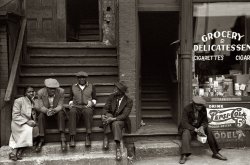
- Big Sky: 1942
- ... Montana, in September 1942. 4x5 Kodachrome transparency by Russell Lee, Office of War Information. Anyone see their house here? View full size. ... Posted by Dave - 02/27/2014 - 9:49am -
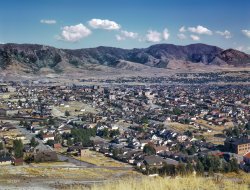
- Nulaidies: 1942
- ... eggs into cartons." Medium format acetate negative by Russell Lee for the Farm Security Administration. View full size.
To be on the ... Posted by Dave - 04/29/2022 - 10:48am -
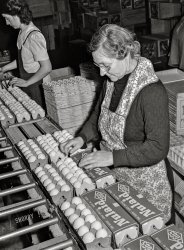
- SuperPipe: 1941
- ... Dam to the hydroelectric turbines." Acetate negative by Russell Lee for the Farm Security Administration. View full size.
Construction ... Posted by Dave - 04/30/2022 - 6:56pm -
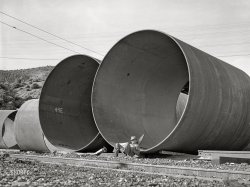
- Home of the Brave: 1942
- ... at the Minidoka War Relocation Center. Acetate negative by Russell Lee for the Farm Security Administration. View full size.
Patriotic ... Posted by Dave - 07/19/2022 - 7:45pm -
![Home of the Brave: 1942 July 1942. "Rupert, Idaho. Former CCC camp now under FSA management. Japanese-Americans taking down their flag in the evening." Internees at the Minidoka War Relocation Center. Acetate negative by Russell Lee for the Farm Security Administration. View full size.
Patriotic AmericansAmong the many things we should not forget is that, for its size, the most decorated unit in the history of the United States military is the 442nd Infantry Regiment, organized at the start of 1943, composed almost entirely of Nisei (American citizens of Japanese descent)--and all volunteers. Among their distinctions were 4,000 Purple Hearts, 21 Medals of Honor, and the Legion d'Honneur. One of the Nisei units helped to liberate the Dachau labor camps.
About 33,000 Japanese Americans served during World War II. Many of them had famiiy members being 'interned' or 'detained' or 'relocated' (whatever you call it, it was involuntary) back home.
Take the tour pathHere's what the Minidoka National Historic Site looks like today. The address is 1428 Hunt Road, Jerome, ID. It's a far cry from a West Coast city and there's nothing now to give you a feel for what it was like to be locked inside a barbed wire fence with armed guards in this remote location. Still, Google Street view rolled down the path inside the park. You can arrow around the camp and read the information signs along the way. That's how I found out the long earth mound to the far right in the photo was once a root cellar.
Click to embiggen
What price freedom?I find it sadly ironic that these men are honoring the flag of the country that imprisoned them. Did they do this of their own volition? Can you imagine prisoners in Nazi concentration camps doing this? At least they were fed better (hopefully) and didn't get worked to death.
[The relocation centers were not labor camps. Any work done by the internees was voluntary and for pay, generally outside of the camp, including construction of the Anderson Ranch Dam. - Dave]
48That 6x8 grid of stars is the one I grew up with.
(The Gallery, Relocation Camps, Russell Lee, WW2)](https://www.shorpy.com/files/images/SHORPY-8c25411a1.thumbnail.jpg)
- Oxydol: 1942
- ... "Washday at the FSA Camelback Farms." 35mm negative by Russell Lee for the Farm Security Administration. View full size.
Soapstone ... Posted by Dave - 07/11/2009 - 7:24am -
![Oxydol: 1942 March 1942. Phoenix, Arizona. "Washday at the FSA Camelback Farms." 35mm negative by Russell Lee for the Farm Security Administration. View full size.
Soapstone WashtubWhen I was a kid in the 40's, we had one of these dual tubs in our basement. The water faucet and soap dish were the same also. They probably weighed 300-400 pounds. Three years ago, my wife and I had our kitchen counters made frome this stone. It weighs 20 pounds per square foot.
Cute but not too brightWe had a tub ringer washer in the back yard under a pole shed in the early 50's. I of course being a 4 or 5 year old boy was fascinated by it .Mom would leave it unattended once in a while and I would take advantage by seeing what I could put through the rollers (mostly blades of grass, weeds, and I tried a cat once. The cat was not amused and scratched me up pretty bad before he made his escape). Several times I caught my arm in the rollers.I would start screaming and she would come running out and hit the release and pull me free. Wish I could tell you it only happened once.
Wringer Pain!My grandmother used to roll her big tub washer out on the big front porch to do the laundry. Like Fanhead, I loved to put things through the wringer too -- and got caught at least once. I still remember how much that hurt -- some 60 years ago!
How did we all manage to live through machines like this?
Soapstone or concrete?The house I grew up in had a double sink like those in the picture (and I can remember the wringer washer too). Ours though was concrete and when it (and the wringer washer) got replaced, we knocked out the center partition, buried it in the back yard, and had a beautiful goldfish and lily pond for all of the years we lived there.
Oxydol in actionIf you want to see Oxydol in action, there's a fantastic film from the Prelinger Archive. You'll note that this woman is much prettier than the actress housewife in the film.
Washday workoutWho needs aerobics classes. No wonder that generation was thinner -- from real work.
Ironer LadyMy mother had an electric mangle. It cut down on the ironing (for seven children and a college prof husband). She was very careful to not just turn it off but unplug it and stow the cord away when she was done. Little pitchers have prying fingers.
Thanks, FanheadI had forgotten about the quick release on the wringer, but I can't say I ever got caught. However, I do remember my mother had a washing machine on the back porch powered by a gasoline motor -- probably late 1940s. About the same time, my uncle owned a dry cleaning business. There were some awesome and frightful machines in there as well.
Washday TalesSmall brown bottle of Clorox bleach on shelf behind the lady.
I grew up with every Monday being washday. ALL DAY. First load was delicate whites, then regular whites, followed by colored clothes, with Daddy's overalls last. Rugs were *dead last.*
Two best tales: before I knew the washing pecking order, I once let my 1960s madras shirt ("guaranteed to bleed") share the washer with Daddy's overalls. For about three weeks, Dad had pale pink striped Big Smith overalls . . .
One day, toward the end of the washing cycle, Daddy asked if I would wash the gunny sacks he used on his fishing trips. Let them wash for about a half hour and then put them through the wringer into the rinse tub. The last one would NOT go through the wringer -- it took about three or four tries of raising up the wringers to accommodate it. When I threw the sacks over the fence to dry, a small bullhead fell out -- with a distinct curve to it!
My mother had one of these tooIn the early 70s. I remember that when we finally got a real washing machine (and given my dad's talent at frittering away money on worthless doodads, that was an event), Mom dragged the wringer washer into the back yard and smashed it up with a hammer so that nobody would ever be forced to use it again. She hated that thing with the fire of a thousand suns. I remember her taking two jobs so that we could afford modern appliances, and my dad whining all the while that "the old stuff is good enough and you're just being picky." Of course he never did a load of laundry or washed a dish in his life.
Trapped in my own mindsetMy first thought on seeing this was, "Wow. That's a LOT of pasta!"
Modern TechnologyLooks like there is an "EASY" button on the front of the roller section, wonder why she is not using it?
[That could be truer than you think. Easy was an early manufacturer of washing machines. The round tub in the foreground might be an example of the Easy SpinDrier. - Dave]
Those Sinks!We also had those same double sinks in our farmhouse "utility room." Long after my mother got a modern washer the sinks were still put to good use. Even though I was barely tall enough to reach into the sinks, it was my job each day to stand on a wooden stool near the sink and wash the dozens of metal pieces (some with sharp edges) that made up the attachments to the motorized cream separator. The big sinks were used to soak my dad's greasy clothes, to wash the dog, and the most fun of all was that my brother and I got to use the sinks simultaneously for our baths. I remember the sinks had washboard ridges in the slanted walls.
Speaking of the fire of a thousand sunsYou all are going on about the washing, but my first thought was "Ugh, living in Phoenix before air conditioning." Even with A/C it's pretty unbearable-- it's supposed to be 114 this weekend. Those poor, poor people.
(And don't believe that "but it's a dry heat" nonsense -- so's an oven)
Soap FlakesAnybody remember the Oxydol competitor back then that my mom bought called Lux? There used to be an hour-long broadcast Sunday nights from Hollywood, "Lux Radio Theater," that featured big-name movie stars. It was always a fight because it finished late and we couldn't listen 'cause Monday morning came by early for school.
Oxydol taught me to read.According to my mother, the big O on the Oxydol box caught my attention when I was about 3 years old. She explained how that big round thing stood for the letter O, and how each of the other things stood for other parts of the word. From then on I started looking at other packages and learning more letters and words.
Wringers, sticks and Oxydol!That box of Oxydol brings back memories of my childhood! I can still see my mom cursing that wringer washer. I grew up in rural Oregon in the 1950s. Saturday was washday and I was assigned to help my mother. To this day I can still see her with a stick forcing things through the wringer and her telling me how dangerous it was. She would cuss like a sailor, and sometimes had a cigerette hanging from her lips. In the meantime I would run outside so she couldn't see me laugh until it hurt. Precious memories!
Amos n' OxyThe commercial power of Oxydol was demonstrated by its being the sponsor of the long-running No. 1 radio program of the era, "Amos n' Andy."
Haircut the hard way My stepmother got her waist-length hair caught in the electric wringer as a child. Ripped a big patch of scalp right off of her head. She said it was so traumatic that she cut her hair short after that and never wore it long again.
About Lux soap: When I told a friend of mine that I was going to name my daughter Lucy, she asked me what the name meant, and when I said that it was from the Latin for "light" -- lux -- she decided that Lux would be a great name for a girl and lobbied very hard to get me to use it. I told her that anyone over a certain age who met my child would think "soap flakes," which was not exactly the effect I was hoping for. I guess I could have named her sister Palm Olive!
Wringer washerMy Mother got her arm caught in one of these at around this time in the early 40's. As she's gotten older, the residual effects of this have become more visible. You can actually see where her little arm was flattened out.
Kind of runs a chill up your spine to be honest.
I love the Oxydol packaging btw.
Through the wringerI worked for Maytag in Newton, Iowa. We produced millions of wringer washers but they didn't look quite as primitive as this one. We built them with electric or gasoline motors so they could be used out where electricity hadn't reached yet. Seems so long ago. Our parents for the most part worked much harder than we do. That type of wringer was a luxury for them. Thanks for the memories.
Generic ever sinceMy late grandmother had generic terms for most things -- any cooler was a Frigidaire, and any laundry product was Oxydol!
My mother's handMy mother ran her hand through the wringer back some time in the 50s. She started to panic. Fortunately, my grandmother was there, and she calmly ran the wringer backwards to get Mother's hand out. But she still has a white spot covering the back of her hand.
Tubs bring back memoriesWe lived on our grandparents' farm in the late 50s. They had a utility porch with tubs like this. There was always a bar of Lava soap in the soap dish, which Grandpa used to wash up, when he came in for dinner. My sister and I always begged to be able to take our baths in the stone tubs (actually, I probably did, since she was barely old enough to talk at the time.) Once in a while, our request was granted. I vaguely remember a wringer washer on the porch, too, but I wasn't allowed out there when it was in use.
(The Gallery, Russell Lee)](https://www.shorpy.com/files/images/8a30955u.thumbnail.jpg)
- Cozy Corner: 1941
- ... of Boundary Farms FSA project." Acetate negative by Russell Lee for the Farm Security Administration. View full size.
Lassie? I ... Posted by Dave - 02/10/2022 - 2:02pm -
![Cozy Corner: 1941 September 1941. "Living room of farm family, members of Boundary Farms FSA project." Acetate negative by Russell Lee for the Farm Security Administration. View full size.
Lassie?I like the collie print on the wall. Is it some famous piece of art?
Sofa so goodIt certainly looks like a Pendleton blanket covering that couch. I have two (the oldest dated 1930). They wear forever. This couch is quite attractive.
Bigger artwork would be niceI recognize the curtains, table, and plant on the table from the previously posted photograph titled Air Chief: 1941, which Dave stated is related to a subsequent photo Planters' Porch: 1941. To me this woman looks too young to be the mother and wife of the men on the porch. But whoever is the homemaker, they keep an admirably tidy house.
[She could certainly be the younger farmer's wife. - Dave]
We're not in Oz anymoreand the young lady seems to have taken Dorothy's ruby slippers.
She of the Swiss Dot PriscillasThis young mother is a meticulous housekeeper, obviously invested in making her humble home attractive for its occupants. I can only imagine how many times she had to straighten and adjust those towels and the blanket which protected the furniture. Her little pictures on the plywood walls are so poignant. She wanted beauty around her.
Safely guardedIdyllic moment, I can "sense" the love permeating the room. Title equally applies to the print of a collie dog guarding the sheep.
Safely GuardedI found the artwork on the wall, is called "Safely Guarded" by J Adams.
DecorSome maple stain and their home would look like the 1970s.
As ifThe prints on the wall were shrinking so fast and about to disappear, sofa is getting larger and larger in that corner.
(The Gallery, Agriculture, Kids, Russell Lee)](https://www.shorpy.com/files/images/SHORPY-8c22383a.thumbnail.jpg)
- War Games: 1942
- ... group. War games are popular with the boys." Photo by Russell Lee, Office of War Information. View full size.
Ouch! That's quite ... Posted by Dave - 06/24/2022 - 9:57pm -
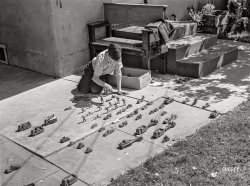
- Buttermilk Junction: 1937
- ... Ethyl and Acidophilus. Medium-format nitrate negative by Russell Lee. View full size.
You won't find this spot on a map today. ... Posted by Dave - 11/14/2012 - 2:26pm -
![Buttermilk Junction: 1937 April 1937. "Buttermilk Junction, Martin County, Indiana." Fill 'er up with Ethyl and Acidophilus. Medium-format nitrate negative by Russell Lee. View full size.
You won't find this spoton a map today. I'm sure all existing buildings, etc. were bulldozed in about 1940/41 when the Crane Naval Base (actually, its predecessor, the Naval Ammunition Depot) was built here.
Linco GasolineLater absorbed by Marathon.
*Almost* everythingIt still needs Percy Kilbride.
Buckboards1880s version of the pickup truck -- "Hey I need to move some stuff, can I borrow your buckboard?"
This place has everything.Horsedrawn wagon, combustion engines, gas and chickens. Would love to find this spot on a current map.
I don't know about you but my bones denounce the buckboard bounce, and yes, the cactus does hurt my toes, but I don't see any here so I'll let that slide.
Deux ChaveuxThe station wagon in the middle looks to be about two horsepower.
That first stepWatch out for that first step "It's a doozie"
I'm not a structural engineerbut there isn't much holding up that porch roof and the three 2x4's being asked to do the job are looking a bit tired!
LP CoverYazoo Records used this photo on the cover of a blues compilation LP, Lonesome Roads Blues. Interestingly, they used it for songs from the Mississippi Delta.
McNab StoreI contacted the Martin County Historical Society, and here's what they found:
I did some research today on "Buttermilk Junction." As I stated before, we had never heard of it. I found an old photo in one of our books & it was called "The McNab Store" - now the site of Building 101 on the Crane Naval Depot. Our book does not mention it going by any other name.
Jane Marshall/Secretary
Martin Co. Historical Society
Rock-faced concrete blockIf I'm not mistaken, the façade of what is undoubtedly a balloon-frame building is composed of "rock-faced" concrete block, which would date the structure's origin to no earlier time than 1900, when such block were first beginning to be introduced.
[Looks like sculptured tin siding. -tterrace]
(The Gallery, Cars, Trucks, Buses, Gas Stations, Russell Lee)](https://www.shorpy.com/files/images/SHORPY_8b30314a.thumbnail.jpg)
- Fiesta Bawl: 1940
- ... Spanish-American fiesta in Taos, New Mexico. Photograph by Russell Lee, July, 1940. View full size.
re: Spanish-American Spanish-American is the term used by photographer Russell Lee.
Spanish-American? Isn't this a Mexican-American fiesta, not ... Posted by Ken - 09/08/2011 - 8:37pm -
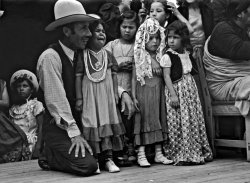
- Flipper: 1942
- ... First aid class." Today's lesson: finger splints! Photo by Russell Lee for the Farm Security Administration. View full size.
LOL ... ... Posted by Dave - 04/21/2022 - 8:57am -
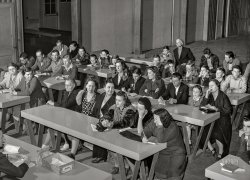
- Tractor & Imp.: 1941
- ... for sale and repair shop in Colfax, Washington." Photo by Russell Lee for the Farm Security Administration. View full size.
Caterpillar ... Posted by Dave - 02/07/2022 - 11:55am -
![Tractor & Imp.: 1941 July 1941. "Washington wheat country. Farm machinery for sale and repair shop in Colfax, Washington." Photo by Russell Lee for the Farm Security Administration. View full size.
Caterpillar TractorsBoth tractors are Caterpillar "Agricultural Crawler Tractors," according to TractorData.com the Twenty Eight was built 1933-1935. The Diesel Forty was built from 1934 to 1936.
Interestingly, the site says no photos of the Diesel Forty are available! I sent them a link!
Hats off to Owen CareyThe sign painter who lettered and painted this example of signage from days gone by. Letter forms look fine and well lettered to me, based on the rough background painted on. Well done, sir.
[Ogden, not Owen. - Dave]
WeedsWaiting for the invention of Roundup.
Hats off to Ogden.That signature looks to me like "Ogden Carey."
Perfect Post PlacementPerfect framing of the lamp post shadow between the corner of the building and the edge of the window. One wonders if Photographer Lee planned his exposure for when the Sun would provide such perfect placement.
[He took over 750 photos that month, so probably not. - Dave]
Chairs of SteelAs a kid I remember these metal lawn chairs at summer cottages and in motels. They got hot in the sun, and you had to test the surface temperature before you sat down in a bathing suit.
I love the perfect framing of the shadow of the old post top street light. These fixtures are still available, and small towns have put them back as part of restoration projects.
Limited supplyLooks like they’re all sold out of Hoyt Clagwell’s.
Foley Catthis distributor is well known in the Kansas area as the cat dealer
Just askingAnyone know what the "Imp." stands for?
[Implement. - Dave]
Not picturedFoley's sister store across the street: Plow and Puck.
(The Gallery, Agriculture, Cars, Trucks, Buses, Russell Lee, Small Towns)](https://www.shorpy.com/files/images/SHORPY-8c22338a.thumbnail.jpg)
- Shawnee Tavern: 1937
- ... law offices." Now home to a newspaper and a bar. Photo by Russell Lee for the Resettlement Administration. View full size.
Deposeyed. ... Posted by Dave - 10/28/2015 - 11:43am -
![Shawnee Tavern: 1937 April 1937. "The Posey Building of Shawneetown, Illinois, in which Abraham Lincoln and Robert Ingersoll had law offices." Now home to a newspaper and a bar. Photo by Russell Lee for the Resettlement Administration. View full size.
Deposeyed.These steps are all that remain of the Posey Building.
Wrong addressThe Posey building was in Gallatin
597 Main St
Gallatin, IL 62984
[Gallatin is not a town, but rather a county in Illinois; the county seat is Shawneetown. 62984 is the ZIP Code for Shawneetown. -tterrace]
Old ShawneetownAccording to Wikipedia, Shawneetown was heavily damaged by the Ohio River Flood of 1937, and the townsite was moved three miles inland and the town rebuilt. From the age of the buildings here, this must be what is now called Old Shawneetown (refer to the previous picture posted here for another building destroyed by the flood). The county seat is now in what is informally called New Shawneetown.
Gallatin DemocratThe newspaper is still being published:
Fred Murphy is the editor of the Gallatin Democrat.
Mailing address: PO Box 545, Shawneetown, IL 62984
There's no website for the paper though.
When was it torn down?Does anyone know when or why it was torn down? Seems like such a historic building should have been preserved. Or maybe the flood took its toll on it. Is that the high water mark I see?
Ghosts of Old ShawneetownWhen I lived in Southern Illinois in the 60s and 70s, most of the buildings along Main Street were still standing, although not in the best condition. I recall that most of them seemed to house a bar. Old Shawneetown was known as a hard-drinking very rough place. The denizens were commonly referred to as river rats. The decline began after the flood of 37 (which Russell Lee's photographs are documenting) and the Federal government paid to resettle the town on top of the bluff above the Ohio River, today known as New Shawneetown. Today there are only a couple of old downtown buildings still standing. One, the state bank building, shown recently in another Russell Lee shot, is an Illinois Historic site. The exterior is still in fairly good shape, or at least was when I last saw it about 4 or 5 years ago. The interior, unfortunately is crumbling lath and plaster and murals. You cannot go inside. The other major building still standing, on the levee side, is now a big regional biker bar called Hog Daddy's.
Same hydrantIt looks like the hydrant in the old photo and the one in the Google street view are one and the same.
(The Gallery, Cars, Trucks, Buses, Gas Stations, Russell Lee)](https://www.shorpy.com/files/images/SHORPY-8c51242u.thumbnail.jpg)
- Fairly Fun: 1942
- ... El Centro, California." Medium format acetate negative by Russell Lee for the Office of War Information. View full size.
What could go ... Posted by Dave - 06/15/2022 - 4:36pm -
![Fairly Fun: 1942 March 1942. "Boys. Imperial County Fair, El Centro, California." Medium format acetate negative by Russell Lee for the Office of War Information. View full size.
What could go wrong?Just as so many YouTube videos show now, guys and gals in this age group run around, absolutely convinced that nothing bad can happen to them; and never thinking five seconds into the future.
Not seriousWhile not saying that this lot would never try such a stunt, the photo is pretty clearly staged: There is no motion blur (especially in the wheel spokes), no dust being kicked up, and isn't the starter crank normally removed once the engine is running?
[Look closely and you will see the trailing halves of the wheels are indeed blurred. - Dave]
It's all fun and games for the moment ...I can't help but think about the fate of these young men, especially the driver, after seeing the date of this photo and wondering their fate. Pearl Harbor had just been attacked in Dec 1941, and on Feb 19, 1942 FDR signed Executive Order 9066 authorizing the Secretary of War to establish Military Areas in which persons of Japanese heritage began being evacuated to on April 11, 1942.
InternmentI wonder what happened to the young man driving? He looks as if he could be of Japanese descent, and to our shame, many families were placed in Internment camps across America from 1942 to 1945. That day, however, he was happy with his buds. Perfect moment in time captured for all time.
The Asian driverThis photo is dated one month after President Roosevelt's notorious Executive Order 9066, which resulted in the internment of 120,000 people of Japanese ancestry, mostly from California.
Not well known today is Life Magazine's December 22, 1941 article, "How to Tell Japs from the Chinese," which had the subtitle "Angry Citizens Victimize Allies with Emotional Outburst at Enemy."
I don't know what this young man's ancestry was, but I expect that, despite this joyride, he was having some tense times in March 1942.
Old GloryDid anyone notice the American flag decal proudly displayed on the Model T's windshield? I think these Imperial Valley teens were likely not shy about their patriotism, at an especially high-level during WW2.
Half-blurredHow would the front halves be still while the backs blur?
>> the trailing halves of the wheels are indeed blurred
[This has been the subject of considerable discussion here and elsewhere. It has to do with the direction the camera shutter is traveling (top-to-bottom, left-to-right, etc.) relative to the motion of what you're photographing. An effect especially pronounced in photos of cars and carriages made with the slower exposures and focal-plane shutters the glass-plate era, where we see only half of each wheel. - Dave]
The crankHaving recently owned a model T Ford, I can tell you that the crank stays in place when not in use. Note the coil spring on it. The crank must be pressed in to engage the crankshaft, then with the spark fully retarded, quickly cranked over. If done wrong, it can kick back possibly causing a broken arm. When done correctly, it usually fires right up and the spring retracts the crank out of the way. It actually works very well.
Re: Half-blurredBut, a focal plane shutter in a 1942 medium format camera? I would expect an iris shutter. And I really don't see an motion blur.
[Look harder. The Speed Graphics that made these photos used a focal-plane shutter. - Dave]
Aftermarket body?I see a door outline on the drivers side, but it doesn't seem to have a handle or hinges. Did Ford make them that way?
[Yes. - Dave]
(The Gallery, Cars, Trucks, Buses, Russell Lee)](https://www.shorpy.com/files/images/SHORPY-8c24282a.thumbnail.jpg)
- Nurse Noir: 1942
- ... Center clinic of FSA farm workers' community." Photo by Russell Lee for the Farm Security Administration. View full size.
JPEG of the ... Posted by Dave - 05/26/2022 - 3:51pm -
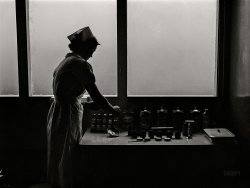
- Tired Treads: 1937
- ... -- Minot, North Dakota." Medium format acetate negative by Russell Lee for the Farm Security Administration. View full size.
Somehow ... Posted by Dave - 12/14/2018 - 1:52pm -
![Tired Treads: 1937 October 1937. "Used tires -- Minot, North Dakota." Medium format acetate negative by Russell Lee for the Farm Security Administration. View full size.
SomehowThis whole thing just begs for a Laurel & Hardy response. What potential for a really funny short!
Re: Ring tossOf course Dave is right. But please note, 1pictureisworth1000words: the stack on the right is on a shorter log than the one on the left, and it is NOT the log directly behind this short one, with wires attached. Look closely: there are three separate logs here. (Four, if you include the really tall one on the far right which is painted white where there are no climbing pegs.)
[Executive summary: The stack on the right is in front of a utility pole. - Dave]
Good ReceptionMost antennas ever.
Ralphie as an adult"My old man's spare tires were only actually tires in the academic sense. They were round and had once been made of rubber."
HOW ON EARTH?Just wondering how on earth they got those old tires stacked on such tall poles--especially the one that has utility wires running to and from it. My guess is that they must cut the tires to open them for placing on the stacks. Any other guesses?
[Ring toss! - Dave]
North Dakota?These were probably used to measure snow depth.
VulcanizingGet your ears pointed for free with purchase of four tires.
Hi ho the glamorous life Russell Lee must have been a real trouper. He went all the way to Minot, just to capture the majesty of these used tires. I can almost smell the filthy things.
Déjà vuNow it all makes sense.
Motto of Minot"Why not Minot?"
The answer: forty degrees below zero.
Backup motto of Minot:
"Forty below keeps the riff-raff out."
LocatedOpposite the Court House.
Mosquitoville!The clouds of bloodsuckers must have been impressive.
Pole on the rightIs used when they have to move the stack from one pole to the other while retaining the top-to-bottom order.
(Towers of Hanoi -- undergrad recursive programming exercise)
Culicidae TowersI can only imagine the number of mosquitoes growing inside those tires during warm, wet periods.
(The Gallery, Cars, Trucks, Buses, Gas Stations, Russell Lee)](https://www.shorpy.com/files/images/SHORPY-8b20081a.thumbnail.jpg)
- Student Bodies: 1941
- ... Guy With the Eyebrows. Medium format acetate negative by Russell Lee for the Farm Security Administration. View full size.
Hall passes ... Posted by Dave - 03/19/2022 - 8:43pm -
![Student Bodies: 1941 September 1941. Hermiston, Oregon. "Crowded halls in high school between classes." Another look at the Kids in the Hall last seen here, including That Guy With the Eyebrows. Medium format acetate negative by Russell Lee for the Farm Security Administration. View full size.
Hall passesPencil-in-the-teeth certainly is feeling his oats, and I'd wager that Mr. Eyebrows is suave and sanguine eight days a week. I do see the tall, confident, athletic girl and her hair ribbon and the star on her collar and her charming smile ... good eye, davidk. What a cutie she was! But then, there are lots of cute girls in the shot and everyone looks so good-natured and wholesome. I do long for days gone by, when a certain youthful innocence was not confined to those under the age of six.
PDAPencil Mouth makes his move.
So BrightThe flash, it is strong.
Feminine fillyNever mind the guy with the eyebrows. If I’m not mistaken, immediately to the right of him is the “tall, confident, athletic but feminine filly in the white dress” that reminds JennyPennifer of her mother-in-law in the previous post (linked by Dave to this one). Same bow in the hair, same black star on the white collar, only this time with a radiant smile. What a charming lady. And I may have wondered this before, but why is it that all the girls look like women while so many women nowadays look like girls?
Three Fingered JackThe hand coming from the open locker on the left and wrapping itself around the young lady's neck seems out of place. It appears to be a hand of someone much older. Eerie.
[It belongs to Pencil-Boy. - Dave]
Traffic patternsThe motion is reminiscent of freeways in Los Angeles. Everybody over There wants get over Here while everybody over Here wants to get over There. All at the same time.
ClasstrophobiaYikes!
The Petrie BroochThe young woman in the lower right-hand corner of the photo looks like she is sporting a mini-version of the Petrie family heirloom. The heirloom is a large gold brooch shaped like the continental United States, with gemstones marking the cities where Petrie men were born. Obviously, there's a gemstone for Hermiston, Oregon!
Imagine the horrorThe horror of a young lady with naturally straight hair. Akin to the disappointment of a young woman having curly hair in 1969.
What is 95?Answer: The average age of these kids if they're still alive.
(The Gallery, Education, Schools, Kids, Russell Lee)](https://www.shorpy.com/files/images/SHORPY-8c22714a.thumbnail.jpg)
- Little Tokyo: 1942
- ... scene in Little Tokyo." Medium format acetate negative by Russell Lee for the Office of War Information. View full size.
+74 Below is ... Posted by Dave - 06/20/2022 - 1:11pm -
